#historical places in the philippines
Explore tagged Tumblr posts
Text

A Short History of Trans Misogyny
Jules Gill-Peterson
An accessible, bold new vision for the future of intersectional trans feminism, called "one of the best books in trans studies in recent years" by Susan Stryker "A beautifully written and argued book." - Torrey Peters, author of Detransition, Baby There is no shortage of voices demanding everyone pay attention to the violence trans women suffer. But one frighteningly basic question seems never to be answered: why does it happen? If men are not inherently evil and trans women do not intrinsically invite reprisal--which would make violence unstoppable--then the psychology of that violence had to arise at a certain place and time. The trans panic had to be invented. Award-winning historian Jules Gill-Peterson takes us from the bustling port cities of New York and New Orleans to the streets of London and Paris in search of the emergence of modern trans misogyny. She connects the colonial and military districts of the British Raj, the Philippines, and Hawai'i to the lively travesti communities of Latin America, where state violence has stamped a trans label on vastly different ways of life. Weaving together the stories of historical figures in a richly detailed narrative, the book shows how trans femininity emerged under colonial governments, the sex work industry, the policing of urban public spaces, and the area between the formal and informal economy. A Short History of Trans Misogyny is the first book to explain why trans women are burdened by such a weight of injustice and hatred.
(Affiliate link above)
#queer history#queer#lgbt#lgbt history#transgender history#transgender#trans books#transgender books#lgbt books#queer books#nonfiction books
290 notes
·
View notes
Text


sort of revisiting this scene, mostly just playing around with it while I figure out the visual vibe I want bad governance to have! this is more like an abridged version of the scene I ended up writing.
for some scene context, Felix was planning on red tagging Cesar as payback, since Cesar’s family was Felix’s political opponent in the elections, but Crasso convinced him not to do it (Crasso’s family was murdered by cops when he was a teenager. It’s a cycle, baby)
I don’t really like to attach too many Ancient Rome sources for these anymore because it’s not supposed to be a modern retelling (again, the naming conventions were inspired by the Iron Heart, but for fun I thought I’d lean into it more. really ham it up, especially since Ancient Rome has a “relationship” with the Philippines lmao), but we’re still in the fucking around stage so as a treat, I’ll mention that this particular thread was partially inspired by the theory that Crassus might have been involved in getting Sulla to back off harassing Caesar. ymmv on whether or not it’s likely, but for me it’s delicious drama to think about.
I’ve also introduced Seth into the plot because politics and business go hand in hand, like you can’t really do one without the other. This is Seth’s historical counterpart, btw!

Crassus, Catilina, and the Vestal Virgins, Ronald Syme
⭐ places I’m at! bsky / pixiv / pillowfort /cohost / cara.app / tip jar!
#komiks tag#bad governance the series#Bad Governance is like if I hijacked Ancient Rome to scream about regional politics for three hundred pages#and also national politics but to a lesser degree. or maybe not. It’s very much about internal colonialism and imperial Manila#long post
147 notes
·
View notes
Note
Could you recommend me 1-2 good "standard" bl from each of the main bl producing countries (China, Japan, Taiwan, Thailand and South Korea)? I'm interested in the differences in tropes and execution between bl from different countries, especially Taiwan and Thailand. I'm looking for bl that's highly rated because it's well-executed but doesn't stray from the expected formula for its region.
Great BLs that ALSO rep for their country's style
I really took the "represent" part seriously. Here are my (end of 2024) quick pulls, explanations etc in the linked posts at the bottom.

Japan
Seven Days (or I Cannot Reach You)
Old Fashion Cupcake
For the darker stuff: Tokyo in April is

Korea
Semantic Error
To My Star
For their new style of darker stuff: The 8th Sense or Love for Love's Sake

Thailand
These were absolutely the hardest to pick, so I couldn't stick to 2. There's just so much Thai BL.
My School President - best high school rep (heritage = Love of Siam, Love Sick, the true Thai BL beginnings)
Bad Buddy - best uni BL rep (heritage = 2gether, SOTUS, the beginning of Thai BL global dominance) alternative = Oxygen which is possibly the most classic Thai uni BL we have ever gotten (but Bad Buddy is better acted)
We Are - best GMMTV ensemble piece, heritage is actually also Love Sick, but in 2024 everyone is gay.
Lovely Writer - best meta
My Ride - best pulp
The Sign - best wild what-the-actual-fuck? ride (KinnPorshe also an option)
For an example of the few times Thailand got elevated: I Feel You Linger in the Air or A Tale of Thousand Stars. But these are atypical, we only get a few of them a year from Thailand.
Taiwan
These were the easiest to pick.
We Best Love
Be Loved In House: I Do
But actually: History 4: Make Our Day's Count will tell you everything you ever needed to know about Taiwanese BL in one mess of a show. It's just... not that great.
China
Addicted
Word of Honor
The Philippines
Gameboys
My Day
Vietnam
Mr Cinderella
My Lascivious Boss
But by most standards neither of these are actually very good.
Here's a 2022 post where I talk about the differences between country's styles and approaches.
If you want representative samples from a historical perspective than I do that here:
In that post, you'll need to decide what kind of representation you want to consume though, because some are very old, and others newer, since this is set up to learn about the evolution of the genre.
I also wrote a whole series on the history of the genre along with my top 10 picks at the time (2022). It's old now but still holds up for what you want. I would say pick any two from the top ten of each list, but please understand my personal taste leans toward the lighter fluffier fare. (Which means my top ten from places like Japan is very skewed. Also several countries have added new top 10, for me personally, in 2023 & 2024).
Here's a fun one on the tropes people love in the different countries
And a personal favorite, very silly and not helpful at all.
(source)
#asked and answered#bls that best represent for their country#bl by country#bl style by country#bl tropes by country
56 notes
·
View notes
Text
youtube
Hello pirate friends! Those of you who know me through Rusty Quill's Trice Forgotten know that I love to write queer and trans Asian pirates destroying colonies with science and also homoerotic swordfighting.
If you like those things in combination with radical, genre-devouring new science-fiction musicals created as a "fuck you" to the white men who've made millions casting East and Southeast Asians as barbarians and lotus flowers, look no further than ASIAN PIRATE MUSICAL!
APM is created by a group of 6 trans/genderqueer/female artists from across diasporas including Malaysia, the Philippines, Jamaica, Japan, Thailand and New Zealand. We love musical theatre, but we want fun, epic adventure stories written by us, about us and casting us. For tone, think the queer humour of Our Flag Meets Death meets the political world-building of The Expanse, with an experimental, orchestral blend of traditional instruments, 21st century Asian pop and indierock.

Here's a bit of a call-to-arms for us as we need some help giving this project its sea-legs.
If you're in London, UK 21-22nd November 2024, we're having a 2-day CONCERT at the Pleasance Theatre. Tickets are £14 and we need to sell out to break even ( ;; yay theatre) Click here to buy tickets.
We want everyone to be able to access this show for free, online. To do that we're recording a studio cast album (think Hadestown's early demo albums, or the EPIC! musical). We've currently got a crowdfunder going, and any donation - however small - is much appreciated. We're at £1,265/£5,000 and that just covers basic costs. Click here to go to the crowdfunder.
If you don't have the ability to financially contribute at this time, we would super appreciate any kind of social media help -> sending people who might be interested our way, reblogs/retweets and shares on Instagram/Tiktok go an incredibly long way in the development of musicals. We're @ AsianPirateMus in most places.
If you want to learn more about Asian Pirate Musical, including more songs and our social media links, please head over to this linktree and follow us where you can!
If you made it this far, thank you! Here's our asian-pop inspired ballad in which we make a historical old man have homoerotic thoughts and feelings for his Emperor.
youtube
#asian pirate musical#rusty quill#trice forgotten#our flag means death#hadestown#epic the musical#musical theatre#theatre kid#pirate queen#one piece#musical theater#les miserables#les mis gang i'm tagging you here because i'm one of you and desperately want you to know that we do have old man crimes AND old man yaoi#Youtube
95 notes
·
View notes
Text
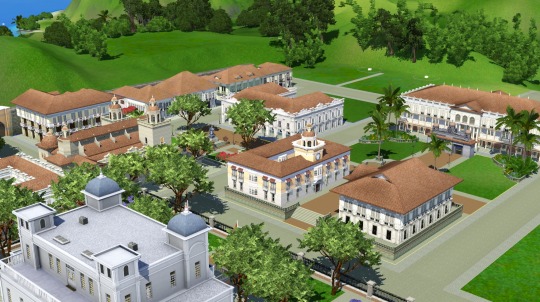
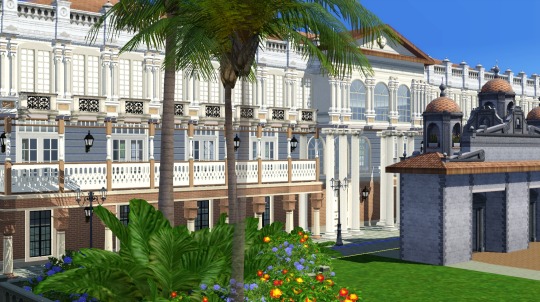
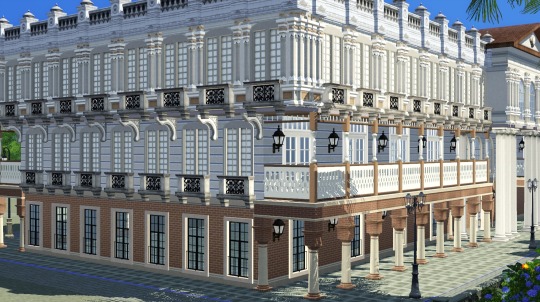
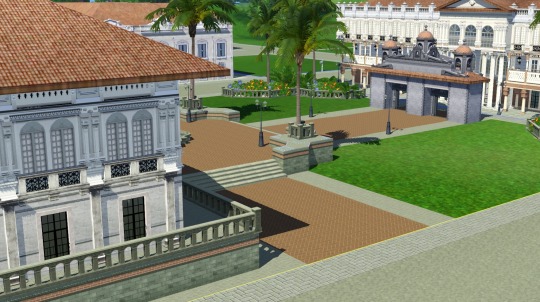
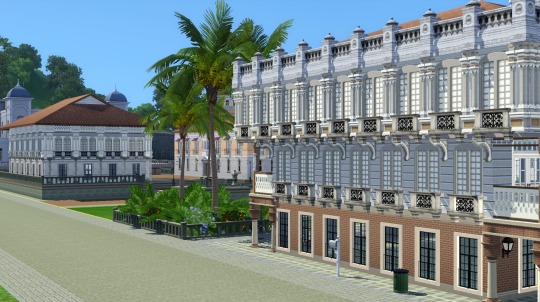
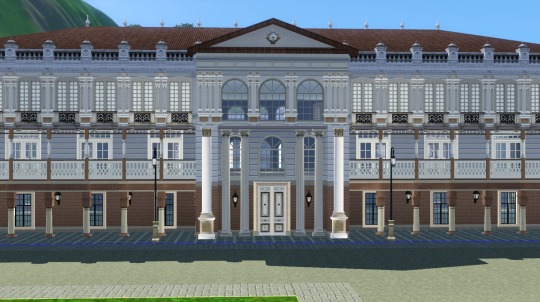
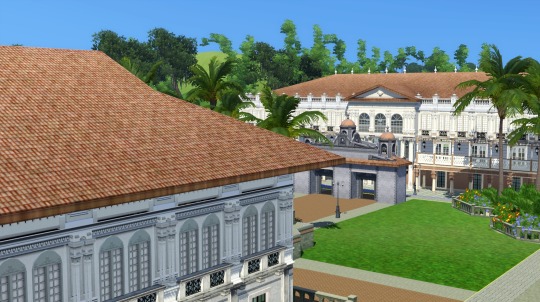
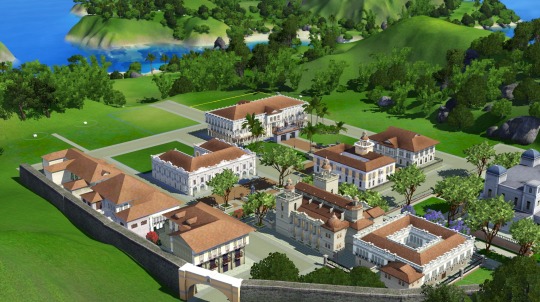
A large luxury hotel built smack dab in the middle of the plaza. Still not sure what to make of it yet, as it could either be a swanky deluxe dormitory, a luxury lounge, a rabbit hole of some sort, or even a resort (where does the large pool go, though?). It's based on a combination of buildings (real world hotels at the Las Casas Filipinas resort and living history museum), one a combination of hotels styled after a historic accesoria and the reconstructed Hotel de Oriente, which used to stand in what is now Plaza San Lorenzo in Binondo.
One of my tentative names for it is the Hotel McCarric, indicative of the owners of the hotel and a deliberate shout-out to @danjaley's McCarric Scenes. I floated up the possibility of having that family in the save a while back. The McCarric family I've planned for this save was one of those merchants who made it big here and decided to invest on a large venture in the walled city. They're likely very distant relatives or descendants of those McCarrics, having made their fortune as traders in hemp rope and sugar.
Historically, this is actually very plausible, as the British had a sizeable presence in Philippine cities as entrepreneurs.
Anyway, about that arch. Should I keep it in place or reconstruct it in front of Fort St. Simeon instead?
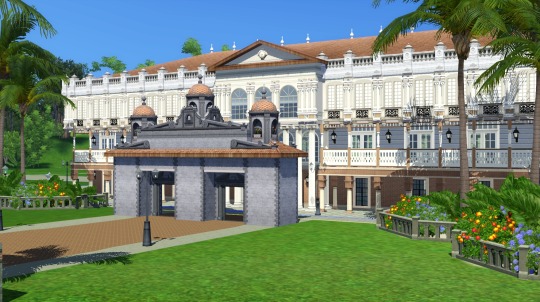
59 notes
·
View notes
Text
Excerpt from this story from RMI:
1. Batteries Become Everybody’s Best Friend
Battery prices continue to drop and their capacity continues to rise. The cost of electric vehicle (EV) batteries are now about 60 percent what they were just five years ago. And around the world, batteries have become key components in solar-plus-storage microgrids, giving people access to reliable power and saving the day for communities this past hurricane season.
2. Americans Get Cheaper (and Cleaner) Energy
State public utility commissions and rural electric co-operatives around the country are taking steps to deliver better service for their customers that also lowers their rates. At the same time, real momentum is building to prevent vertically integrated utilities from preferencing their coal assets when there are cleaner and cheaper alternatives available.
3. A Sustainable Shipping Future Gets Closer
More than 50 leaders across the marine shipping value chain — from e-fuel producers to vessel and cargo owners, to ports and equipment manufacturers — signed a Call to Action at the UN climate change conference (COP29) to accelerate the adoption of zero-emission fuels. The joint statement calls for faster and bolder action to increase the use of zero and near-zero emissions fuel, investment in zero-emissions vessels, and global development of green hydrogen infrastructure, leaving no country behind.
4. Corporations Fly Cleaner
In April, 20 corporations, including Netflix, JPMorgan Chase, Autodesk, and more, committed to purchase about 50 million gallons of sustainable aviation fuel (SAF), avoiding 500,000 tons of CO2 emissions — equivalent to the emissions of 3,000 fully loaded passenger flights from New York City to London. SAF is made with renewable or waste feedstocks and can be used in today’s aircraft without investments to upgrade existing fleets and infrastructure.
5. More and More Places Go From Coal to Clean
Around the world, coal-fired power plants are closing down as communities switch to clean energy. From Chile to the Philippines to Minnesota coal-to-clean projects are creating new jobs, improving local economic development, and generating clean electricity. In September, Britain became the first G7 nation to stop generating electricity from coal — it’s turning its last coal-fired power plant into a low-carbon energy hub. And in Indonesia, the president vowed to retire all coal plants within 15 years and install 75 gigawatts of renewable energy.
6. Methane Becomes More Visible, and Easier to Mitigate
Methane — a super-potent greenhouse gas — got much easier to track thanks to the launch of new methane tracking satellites over the past year. In March, the Environmental Defense Fund launched MethaneSAT, the first for a non-governmental organization, and the Carbon Mapper Coalition soon followed with the launch of Tanager-1. By scanning the planet many times each day and identifying major methane leaks from orbit, these new satellites will put pressure on big emitters to clean up.
7. EVs Speed By Historic Milestones
This past year was the first time any country had more fully electric cars than gas-powered cars on the roads. It’s no surprise that this happened in Norway where electric cars now make up more than 90 percent of new vehicle sales. And in October, the United States hit a milestone, with over 200,000 electric vehicle charging ports installed nationwide.
8. Consumers Continue to Shift to Energy-Efficient Heat Pumps for Heating and Cooling
Heat pumps have outsold gas furnaces consistently since 2021. And while shipments of heating and cooling equipment fell worldwide in 2023, likely due to broad economic headwinds, heat pumps held on to their market share through. And over the past 12 months, heat pumps outsold conventional furnaces by 27 percent. Shipments are expected to continue increasing as states roll out home efficiency and appliance rebate programs already funded by the Inflation Reduction Act – worth up to $10,000 per household in new incentives for heat pump installations. Link: Tracking the Heat Pump & Water Heater Market in the United States – RMI
9. China Reaches Its Renewable Energy Goal, Six Years Early
China added so much renewable energy capacity this year, that by July it had surpassed its goal of having 1,200 gigawatts (GW) of clean energy installed by 2030. Through September 2024, China installed some 161 GW of new solar capacity and 39 GW of new wind power, according to China’s National Energy Administration (NEA). China is deploying more solar, wind, and EVs than any other country, including the United States, which is — by comparison — projected to deploy a record 50 GW of solar modules by the end of 2024.
10. De-carbonizing Heavy Industry
For steel, cement, chemicals and other heavy industries, low-carbon technologies and climate-friendly solutions are not only increasingly available but growing more affordable. To speed this process, Third Derivative, RMI’s climate tech accelerator, launched the Industrial Innovation Cohorts to accelerate the decarbonization of steel, cement, and chemicals. Also on the rise: clean hydrogen hubs — powered by renewable energy — designed to supply green hydrogen to chemical, steel, and other heavy industries to help them shift to low-carbon production processes.
27 notes
·
View notes
Text


𝐖𝐇𝐄𝐍 𝐈𝐍 𝐌𝐀𝐍𝐈𝐋𝐀 with Mikey
Mikey's life in Manila with you ♡
♱ a/n: this is for all the Manila Mikey lovers and Filipino girlies ♡ (belated) Happy birthday to our man ❤️🔥
🦇 @hiraethsdesires @sukunassuka @anahryal @half-baked-biscuit @fuyuluvr @iluvizana @saenora

Mikey sat in his tiny apartment in the heart of Manila, looking at the photograph of his late brother on the wall. He had dreamed of this moment for years, ever since his brother told him of the bustling streets, the delicious food, and the warm, tropical islands of the Philippines, his favorite destination. It had taken time, but Mikey was finally here, living in the place of his brother's dreams. And then, the doorbell rang. It was [ Y / N ], the love of his life. “You look beautiful,�� he said to [ Y / N ], smiling as he held open the door for her. “Thank you, Mikey,” she smiled. “You look wonderful yourself.” she blushes, eyeing down Mikey’s simple black pants and camisole outfit; layered with a plain white button-up shirt that exposed his toned shoulders.
They usually plan to have a date around Manila, a city that Mikey had only ever imagined. During jeepney rides with Mikey, he would let [ Y / N ] rest her head on his shoulder and hold her hand the entire ride. And on occasions when the wind blows harshly through her hair, he reaches around her shoulder to hold it for her.
Getting street foods and strolling around the park is a regular occurrence in the relationship. Given that everything that Mikey loves is in it; cheap and delicious food to satisfy his sweet tooth, the town, and you! Mikey’s favorite has to be the pink, frozen dessert, Ice scramble and Turon. And on times when he misses the dorayaki and taiyaki back home, he would just take [ Y / N ] to Mitsukoshi Mall, a big Japan-themed mall in the southern part of the Metro.
But Mikey and [ Y / N ]’s favorite place in the city is Intramuros. While it was now mostly a tourist attraction, there was still a sense of history and beauty in the air. They walked through the ancient walls and narrow streets, passing by old churches and museums, each one with a story to tell. Carriages run by horses still strolled the roads of the historic city, making Mikey ang [ Y / N ] excited to be on a date around Intramuros every time.
The two of them climbed into the classic, horse-drawn Kalesa and settled into their soft, leather seats. The driver smiled and called out a greeting in Tagalog, and the couple greeted back. The Kalesa began to move through the quaint streets of Intramuros, and Mikey and [ Y / N ] watched as the city came to life around them in a unique, old-fashioned way.
Mikey never had a deep interest for the fine arts, but when [ Y / N ] asks to visit the National Museum, he couldn’t pass it up. As they walked through the museum, their hands entwined, they felt the weight of history pressing down on them. It was almost as if they were walking through the pages of a history book, each exhibit a new chapter in the story of this incredible country.
After spending some time exploring the museum, they made their way to Fort Santiago, a historic fortification in the heart of Manila. As they walked through the ancient halls, their footsteps echoing with the weight of history, they knew that they were standing on sacred ground.
As they wound their way through the city, they passed by ancient doorways and carved archways, the scent of incense wafting in the air from the nearby churches, and they made a stop on perhaps the most famous one. As they entered the church, the air grew thicker still with the weight of history. The stained glass windows cast colorful rainbows across the floor, and the faint sounds of prayer and song echoed through the ancient halls.
Mikey and [ Y / N ] found a pew near the back and sat down, hands entwined as they looked around. They marveled at the intricate carvings and the ornate altar, feeling like they were in a different world entirely.
As they sat in the dim light of the cathedral, their hands tightly intertwined as they admired the beautiful architecture and the historic artifacts. Mikey couldn't help but feel a deep sense of love and adoration for her, and he knew that he wanted to spend the rest of his life with her. As they sat there, Mikey leaned in close and whispered in her ear, “I want to marry you here.”
[ Y / N ] stood still, stunned by his sudden confession. But she had always known that Mikey was special, and truly meant what he said. “Mikey,” she whispered back, feeling tears well up in her eyes. “I would love nothing more.”
Mikey and [ Y / N ] return to the Kalesa, watching as the ancient city of Manila passed by. They had had a beautiful day, exploring the National Museum, Fort Santiago, and the San Agustin Church, and now they were ready for one last adventure.
The driver of the Kalesa pulled up to the shores of Manila Bay, and Mikey and [ Y / N ] climbed out, eager to take in the sights and sounds of the ocean. They walked along the coast, watching the waves rock parked yachts and crash against the shore.
The sun was setting, casting a golden glow across the water, and the lights of the city glittered on the horizon. They made their way to the edge of the water, where they found a quiet spot to sit and enjoy the view. They watched as the sun began to sink below the horizon, turning the sky into an endless canvas of red and orange, and the waves crashed against the shore in a steady rhythm.
As they sat there, taking in the beauty of the moment, Mikey leaned in close to [ Y / N ] and whispered, "I want to spend every sunset like this with you. You make me feel like the luckiest man in the world."
[ Y / N ]'s eyes widened in surprise, and she turned to look at Mikey, her heart aching with love and joy. "I feel the same way," she said softly. "I never imagined that I could find love like this, in this place, with you."
As they sat there, hand in hand, surrounded by the beauty of Manila Bay and the magic of the sunset, they knew that they had found something truly special. A love that would last a lifetime, and a lifetime filled with memories of this quaint place that had brought them together.

#tokyo revengers#mikey x reader#manjiro sano#mikey#sano manjiro#sano manjiro x reader#mikey sano#manjiro x reader#manjiro sano x reader#mikey x reader fluff#tokyo revengers fluff
274 notes
·
View notes
Text




okay so basically:

thanks for your 100% unprompted and completely unsolicited enthusiasm everyone >:) god i am NOT doing any full essays because i am forcing myself to hold back on committing to Positions wrt tmuir's various intertexts until after alecto when i have an actually complete narrative to work with, but, to throw together my best effort at an abstract: as we probably know and as many have pointed out before (and as tmuir says in the gtn notes), the name 'dulcinea' references cervantes' dulcinea del toboso, a wholly made up woman whom don quixote projects onto a peasant girl called aldonsa as a necessary 'lady' to his own invented 'knight.' the essential premise of don quixote, put crudely, is that the title character reads an absurd amount of chivalric literature such that he imagines himself to be a knight errant and behaves as such in a period long after the social logics of chivalry make coherent sense; sharp contrasts between idealism and realism (as with the infamous tilting at windmills scene, for example) serve to drive home the absurdity of don quixote’s pretense. within this, the imagined dulcinea del toboso stands as a necessary element to the chivalric ideal that don quixote imagines himself to participate in; the knight’s ‘lady,’ as fictive as the knight himself, must be ‘sweet’ (as of course denoted by her name), of a high social class, genteel, and beautiful according to ideals of upper-class spanish beauty (blonde, pale skin, etc—of course in-text exaggerated to a comic degree). all of this, ofc, tells us something about the social allegiances of the chivalric world.
crucially, don quixote was written in the early 17th century, with the first part being published in 1605 and the second in 1615. the reconquista—the process by which christians took control of the iberian peninsula from its previously muslim rulers—was concluded in 1492, with expulsions and forcible conversions of muslim and jewish populations taking place between 1492 and 1526 and creating a new class of ‘converso’ or new christians, ie. former jews who converted to christianity but lived with a degree of suspicion cast over the legitimacy of their christian practice. (incidentally, a handful of scholars have theorised that miguel de cervantes’ family were converso jews, which i think casts a fun new light on don quixote, but the evidence is too flimsy to justify seriously committing to the reading). immediately following the reconquista was the establishment and expansion of the spanish empire, which by cervantes’ lifetime had grown to cover most of the americas and the philippines. spanish chivalry was articulated via the knightly orders carrying out such a process of christian conquest—first on the iberian peninsula, then exported to the so-called ‘new world.’ by the time cervantes was writing, chivalry had already reached its apex and was in a period of decline; as i’ve already said, the fulcrum of don quixote is this tension between the ideal and the real, this sense that don quixote’s perception of the world is no longer compatible with modernity. cervantes writes of a christian ideal at a time when aspersions were cast on conversos, where the distinction between ‘old’ and ‘new’ christians and fear of the persistence of judaism (and islam, though muslims who were forcibly converted were expelled outright) against persecution undercut this understanding of forcible conversion as a ‘success’ for christianity; far from writing about the ‘old order’ (if you will) with a straightforward elegiac nostalgia, he emphasises its illegibility in the modern period.
as i’ve talked about before, chivalry bears a relationship both to historical periods of christian conquest and subjugation of so-termed ‘infidel’ groups and to contemporary fascist aesthetics, and also holds currency in contemporary articulations of butchness/transmasculinity/queer masculinity/etc. wherein those relationships tend to be elided. one of tamsyn muir’s most prominent registers is the persistent usage of similar such touchstones: from chivalry [via cavalierhood] as a language by which lesbian articulations of desire become possible (cf., obviously, gideon/cytherea, and the ‘medieval’ aesthetics of the seventh house in general) but also as a hegemonic touchstone of an imperialist social formation to jeannemary’s having been named for jeanne d’arc to lyctors as a reference to lictors ie. roman bodyguards who carried fasces in what could plausibly be gesturing to the etymological root of ‘fascism,’ she’s v clearly working with the tensions present in these cultural building-blocks that can be used to construct an empire around the bedrock of catholicism & antiquity and to situate queerness (largely focalising lesbianism) comfortably within it.
so, like—what’s the don quixote thing doing? like, why reference a picaresque from the 17th century, rather than an ‘actual’ chivalric romance?
there’s a fairly straightforward, surface-level reading to be done here: the crucial dimension of pretense and artifice that cervantes adds to don quixote’s ‘knighthood’ maps pretty clearly onto gideon, and dulcinea as a woman who is very much Not Real but in fact a ‘disguise’ formed around what she ‘ought’ to be maps equally well onto cytherea. & ofc, cytherea and gideon’s relationship as this process of seduction-inclulcation-tutelage by which gideon ‘learns’ cavalierhood similar to how don quixote’s artifice of knighthood depends upon the presence of dulcinea of toboso in order to make sense of itself; knight-gender (if u will) as relational. much like how the driving tension of don quixote comes in part from our asking, does don quixote realise his own pretense? does his calling himself a knight and behaving as though he were a knight make him a knight in a world where the relation he tries to invoke makes no social sense & he has to literally alter the world around him (windmills into giants, aldonsa into dulcinea) to make it coherent? at what point does gideon not ‘really’ being a cavalier stop mattering, and how much is cytherea facilitating that, and how much is their relationship doubling as an inculcation into a social relation to which she was previously only peripheral? and, obviously, what does the fact that their relationship is pretty transparently predatory tell us about the relationship muir tries to draw between socially sanctioned exploitative relationships, imperialism, sexual violence and its aestheticisation, &c. &c.?
BUT LIKE….i think you can take the reading a bit further and think about the fairly common interpretation of dulcinea of toboso as something of a stand-in for, or else a counterpart to, allegiance to the spanish empire; that a feminised ideal of empire becomes the ‘lady’ to the (arguably conquistadore) knight, and that don quixote’s allegiance to her in turn becomes an allegiance to empire & imperial conquest. & ofc, the falsity of all of this; how ‘idealism vs realism’ then becomes transformed into an ideal of empire vs its reality. what gendered formations are made possible by empire, etc.
i also think you can draw some lines around the shifting balance of power between don quixote & dulcinea of toboso and gideon & cytherea; that don quixote ‘makes’ dulcinea out of aldonsa, but cytherea very much ‘makes’ herself into dulcinea (using a real woman whose identity she stole as a very loose proxy); that cytherea sits in an ambivalent position wherein she at once, unambiguously, holds power over gideon that she exploits (socially, sexually), but also occupies a position of subjectivity not shared by eg. mercy, augustine, gideon the first &c. via her blood cancer & the eugenicist practices of the seventh house; cytherea as a character who seeks power where she has the ability to seek it as an ineffective means of responding to the sites where she finds herself powerless—a trait she v much shares with john gaius, but not with mercy et al.! this ambivalence is best expressed through the relation that naming & renaming & remaking bear to one another in the wider text, which, as we well know, is used as a particular discursive expression of ownership tugging on thematic strings around sexual violence and empire (alecto into annabel; i am deliberately not doing nona spoilers in this post but redacted into redacted as well; you know the drill!); cytherea undergoing that process of obfuscation and recreation at her own behest & at once becoming subject and instigator, invisibilising the ‘real’ dulcinea in doing so & removing the external agent (gideon as don quixote) from the equation … it’s doing a lot of work around the ambivalences of power & agency (sexual and otherwise) happening there! and, of course, ask other questions about, like—as ‘dulcinea’ is an agent in the process of gideon occupying that don quixote-equivalent position, does she not then become a similar agent in cytherea’s occupying the ‘dulcinea’ position—does the relational configuration not go both ways—how much of cytherea, who we receive through gideon’s close third, is her fantasy/idealism/etc. and how much of it is cytherea’s own construction? like, is gideon actually removed from the equation? chicken-egg?
there’s a whole separate argument to be done here as well around palamedes & the ‘actual’ dulcinea/dulcie, and what this invoked projection of an imagined ideal onto a very real woman could do for a more compelling reading of their relationship than just … like, oh he was in love with her, it’s unrequited, sad! well i guess he’s just blown himself up in cytherea’s sickroom. i’m interested in these little undeveloped tendrils of, like … dulcie as a character completely and unequivocally removed from the narrative in gtn, only to establish her own presence in htn but even then only really be made sense of in relation to cytherea (i think All The Time about dulcie wearing predominantly white and cytherea wearing predominantly green … girl help they swapped colours), palamedes as being, iirc, pretty significantly younger than her … and then the fact that you could pretty easily make a case for palamedes’ name being a reference to the palamedes/palomides of the arthurian canon, a ‘saracen’ knight and convert to christianity, what that dimension can do to these readings of tmuir’s invocation of chivalry as a particular social dimension to conquest.
this is all very very roughly sketched out and if i were to ever actually try and pitch a take that wasn’t just a quickly glossed few paragraphs on tumblr dotcom i would absolutely be delving properly into the scholarship around don quixote such that i could produce something somewhat less hamfisted than All This, but. hopefully this gives the broad gist of it, lol!
492 notes
·
View notes
Note
I was just curious but do you have any recs for period dramas about the philippines? I want to expand my period drama watching and im not quite sure where to start
Oh, the monster you've unleashed. YES I do have so many period dramas from and about the Philippines. Unfortunately, not all of them might be accessible to you if you're outside of the Philippines. Some of them are found on Amazon Prime, Netflix, and MUBI though. I'll make sure to put a lil note next to each film if they are. Also! these vary in genre (meaning: not all of them are war films, and some of these are horror films-- because this is me we're talking to, heh). I also have copies of some of these and will make a lil note next to each film if it's available for sharing, though I'll only give the link via DM. Please note, however, that they are all either in Tagalog, Bisaya, and/or other local Philippine Languages and not all of them have subtitles!
I also have very nuanced relationships with all these films, since Philippine History was my undergrad of choice. But to keep this post as brief as possible, I'm not going to talk about them at length. Though I will be including trigger warnings. Also note... some of these movies kinda suck HAAHAHAHA but I had way too much fun watching them so like. Please don't tell me they suck, please. I love them too much.
Also tagging @emmylynnaa because I promised her a similar list.
This is sorted by eras in Philippine History. Enjoy! (under the cut because it got long):
Spanish Occupation Era (1565 to 1898)
GomBurZa (2023) – A film following the GomBurZa, the three native Filipino Roman Catholic priests Gomez, Burgos, and Zamora executed during the latter years of the Spanish colonial era. TW: period typical violence. Furthermore, this is a Jesuit produced film so like. Once again. Take it with a grain of salt.
Jose Rizal (1998) - Jose Rizal's life and works are recounted through a series of non-linear flashbacks which reflect on various aspects of his life - as writer, propagandist, lover, friend, brother, doctor, and the man that inspired a revolution. Available on MUBI. TW: depiction of sexual assault by a priest. I also have a love-hate relationship with this film because on one hand, literally shaped my love of history. On the other hand, it is the MOST idealistic depiction of Jose Rizal ever + very historically inaccurate in many places, please watch this with a grain of salt.
Maria Clara at Ibarra (2022 – 2023) – A series about a girl from the 21st century who is magically transported into Jose Rizal’s famous novels Noli me Tangere and El Filibusterismo (you know, the novels that helped spark the Filipino Revolution against the Spanish). The synopsis sounds cheesy but trust me, it’s very good. Available to watch on the GMA official webpage. I just don’t know if you can access it outside of the country. TW: rape, abuses of the Catholic church, period typical violence, abuses of Spanish colonialists. A personal favorite—the costumes? Divine. And the character arcs are also really lovely. Helps you understand Philippine contemporary culture, too.
Katipunan: TV Mini Series (2013) – A mini-series depicting the creation of the Kataastaasan Kagalang-galang na Katipunan ng mga Anak ng Bayan (or the KKK—no, not the white supremacist group; that’s unfair, by the way, we did it first), the revolutionary organization founded in 1892 by Filipino Nationalists against Spanish Colonialization. Available to watch on the GMA official webpage. I just don’t know if you can access it outside of the country. TW: depictions of rape aftermath by Spanish soldiers, period typical violence, torture, graphic depictions of a corpse. This is a personal favorite of mine.
Hele sa Hiwagang Hapis/A Lullaby to the Sorrowful Mystery (2016) - Andrés Bonifacio is celebrated as the father of the Philippines Revolution against Spanish colonial rule. This eight-hour epic examines this myth, undertaking an expedition into history through various interwoven narrative threads, held together by an exploration of the individual’s role in history. Available on Mubi. TW: it is literally eight hours long. But that’s Lav Diaz for you. I love him, but oh my god is he an acquired taste.
Ang Kababaihan ng Malolos (2014) - The saga of the 20 Filipino women who petitioned for the opening of a school in a time when women weren’t given the chance to do so.
Ganito Kami Noon... Paano Kayo Ngayon? (1976) – Set during the end of Spanish colonization and the start of American colonization. After his mother's death, the simple-minded and naïve Kulas (Christopher De Leon) begins his much-awaited trip to Manila. On his way to Manila, he mindlessly takes on the mission of retrieving a friar's son and bringing him to the friar's residence.
Mallari (2023) - A horror film chronicling the deeds of the first recorded serial killer in the Philippines. This film spans decades, all the way up to present day. It's kinda stupid. Like. Really stupid. That's ok. We watch it because we want to see Piolo Pascual and JC Santos covered in blood. TW: oh my god so many bodies and so much gore.
Filipino-American War and America Occupation (1899 – 1940s) (this era has the best films, actually, if you want a place to start and start strong? start here)
Amigo (2010) - A local leader of a small Filipino barangay must decide whether to keep the peace with the American troops occupying his village or join the insurgency with his brother and son. TW: racism, sexual harassment, graphic depictions of corpses, gore, period typical violence.
Heneral Luna (2015) - Set during the Philippine-American war, Heneral Luna follows the life of one of Philippine History's most brilliant soldier, General Antonio Luna, as he tries to lead his countrymen against colonial masters new and old, and to rise above their own raging disputes to fulfill the promise of the Philippine Revolution. Available on Netflix. TW: short scene depicting the aftermath of sexual assault, period typical violence, and graphic depictions of a corpse. Again, one of my favorites. I have so many happy memories of this film + the fandom it birthed! I miss it sometimes.
Angelito (2018) – The short film that bridges both Heneral Luna and Goyo: Ang Batang Heneral, depicting the brothers Manuel and Jose Bernal – Antonio Luna’s aides-de-camp – and their youngest brother Angel, two days before the General’s assassination. This film you can find on Youtube!
Goyo: Ang Batang Heneral (2019) – The sequel of Heneral Luna, this film follows the story of Gregorio 'Goyo' del Pilar, one of the youngest Generals during the Philippine-American War who fought in the historic Battle of Tirad Pass. Available on Netflix. TW: short scenes of torture, period typical violence, and graphic depictions of a corpse. Again, a personal favorite for the same reasons stated above. Though it’s not as strong as Heneral Luna, I gotta say.
Ang Larawan (2017) - In a musical tale about standing together against materialism, two impoverished sisters anguish over whether or not to sell a painting, the final masterpiece by their recluse father. A bitter struggle for survival against betrayal set in pre-World War II Manila. A personal favorite, oh my god. This film. Oh my god, this film.
World War 2 and its aftermath (1940 – 1950)
Quezon’s Game (2018) - In 1938, Philippine President Manuel L. Quezon, military adviser Dwight D. Eisenhower, along with other notable figures, set out to rescue Jewish refugees fleeing Nazi Germany. Quezon simultaneously deals with a relapse of tuberculosis. Available on Amazon Prime. TW: talk of genocide and short scenes depicting the murder of Jewish people by the Nazis.
Tatlong Taong Walang Dios (1976) - A woman falls in love with a Japanese soldier during the Japanese Occupation in the Philippines; the whole town turns against her. TW: rape. Think Malena.
Oro, Plata, Mata (1982) - Set in the Philippine island of Negros during World War II, it tells the story of how two hacendero families cope with the changes brought about by the war. TW: rape
Kusina (2016) – Her kitchen. The silent witness to the life and love of Juanita. It is her sanctuary, the place where she creates dishes for her family, friends, even enemies and strangers. Through cooking, she gets to know the people around her. TW: violent child birth, death of mother in child birth, sexual harassment by Japanese soldiers. This spans multiple decades, all the way up to Martial Law.
In My Mother’s Skin (2023) - Stranded in the Philippines during World War II, a young girl finds that her duty to protect her dying mother is complicated by her misplaced trust in a beguiling, flesh-eating fairy. Available on Amazon Prime. TW: body horror, gore, explicit depictions of a corpse, period typical violence.
Markova: Comfort Gay (2000) – A coming of age drama film loosely based on the life of Walter Dempster Jr., the last surviving Filipino “comfort gay” (male sex slaves for the Imperial Japanese Army) from World War II. TW: CSA, wartime systemic rape, rape.
Comfort Women: A Cry for Justice (1994) – The story of how two sisters and the rest of the women of Sta. Monica are forced into sex slavery by Japanese soldiers during World War 2. TW: wartime systemic rape, rape, and period typical violence.
Seklusyon (2016) - In 1947, a group of deacons (aspiring priests) on their last week of training are sent to a remote monastery to live in seclusion for seven days to protect them from the devil, who on the last few days of training attempts to break the will of deacons to make them reconsider their choice of becoming priests. During their seclusion, a little girl named Anghela, believed by locals to be a living saint because of her healing abilities, appears at the monastery seeking refuge. Available on Amazon. TW: pedophilia, gore, body horror, Catholicism, religious horror.
Corazon: Ang Unang Aswang (2012) - A psychological thriller film detailing the psychological breakdown of a woman struggling with infertility in post-war Philippines. If you want to see women go feral, this is fun.
Martial Law (1970 – 1980) (actually, you know what? I lied. This era is the era with the best films. God, these are CLASSICS and are the ones that’ll help you understand contemporary Philippine culture the most; definitely start here)
Manila, sa mga Kuko ng Liwanag (1975) - Júlio Madiaga, a 'provinciano', arrives in Manila to search for his beloved, Ligaya. TW: coerced sex work, sexual abuse. Once again, a Filipino cinema classic.
Insiang (1976) - After a teenager is raped by her mother's boyfriend, she sets out to exact revenge on anyone who has hurt her. TW: I mean. It says it right there. Though it’s not actually shown on screen, it is very heavily implied. She doesn’t die in the end, if you’re wondering.
Dekada ’70 (2002) - A middle-class Filipino family struggles to survive in the era of dictatorship. This is a fucking classic in Filipino cinema. Available on MUBI. TW: sexual harrassment, discussion of torture, depictions of wounds and beatings, period typical violence. Martial Law was rough.
Aparisyon (2012) – A psychological drama film set in early 1970s, where the story about the nuns in the period immediately preceding the declaration of martial law by Ferdinand Marcos. The film’s director, Isabel Sandoval, is a transgender woman and an absolute visionary. Her other films Senorita (2011) and Lingua Franca (2019) are also very good, please check it out. All films are available for streaming through the Criterion Channel. TW: rape, religious trauma, period typical violence, Catholicism.
Lihis (2013) - Set in the 70’s during the darkest hours of Philippine History, we follow the story of two young NPA warriors who find themselves entangled in a web of frustration, despair and victory as they fight not only for democracy but also their love for each other. Available on MUBI. TW: Infidelity.
Barber’s Tales (2014) - In a rural town in the Philippines during the Marcos dictatorship, the newly widowed Marilou inherits the town's only barbershop from her husband- a business that has been passed down by generations of men in her husband's family. With no other means of support, she musters the courage to run the barbershop.
Dahling Nick (2015) - Dahling Nick is a docu-drama exploring the life and works of National Artist for Literature Nick Joaquin, who only accepted the National Artist Award on the condition that the Marcos administration release a well-known writer who was being unjustly detained during Martial Law. I love Nick Joaquin. He’s shaped my understanding of the Magical Realist genre far more than any of his contemporaries have. This film is notoriously difficult to get your hands on, so I suggest going to read his anthology by Penguin Classics called the Tropical Gothic instead!
Respeto (2017) - Hendrix is a poor aspiring rapper who wants to make a name for himself in the underground rap battle scene and gain respect in the community. After attempting to rob a second-hand bookstore in the neighborhood, he is discovered by the owner, Doc, an old poet with a haunted past as a dissident. Not necessarily period, but definitely has its roots in Martial Law.
Liway (2018) – A film about the kip, a young boy growing up in a prison as the son of anti-Marcos dissident Cecilia Flores-Oebanda, better known as Commander Liway, during the waning days of the Marcos dictatorship. It is currently streaming on Youtube!
The Kingmaker (2019) - is a 2019 documentary film written and directed by Lauren Greenfield, featuring the political career of Imelda Marcos with a focus on the Marcos family's efforts to rehabilitate the family's image and to return to political power, including her plans to see her son, Bongbong, become President of the Philippines, and the alliance that Bongbong and Imee Marcos established with Rodrigo Duterte in his bid to win the 2016 Philippine presidential election. Available on Youtube! if outside of the Philippines, use VPN.
1980s – 2000s Philippines
Misteryo sa Tuwa (1984) - The fortunes of three impoverished friends and their families abruptly change after an airplane crashes in a nearby mountain.
Alpha Kappa Omega Batch ’81 (1982) – A psychological drama film depicting the titular fraternity's harsh initiation of new batch members as seen through the eyes of pre-med student Sid Lucero. TW: hazing, torture, psychological torture. It’s fucked up, actually.
Himala (1982) – During a total eclipse Elsa, a young girl from rural Philippines, allegedly witnesses an apparition of the Virgin Mary on top of the hill where, as an infant, she was found and adopted by Saling. Said visions change her life and cause a sensation hysteria in a poor, isolated northern village in the midst of drought. TW: rape, religious fanaticism, religious trauma.
Adela (2008) - The story of Adela, which takes place in the span of one day, is a heartbreaking story of a woman who longs for the company of her loved ones. This isn’t actually period. This film just breaks my heart. And of course, it has acting legend Anita Linda in it. How could I not recommend it?
Now Showing (2008) - Rita is named after a famous American movie star whom her late, former actress grandmother once adored. She lives in one of Manila’s oldest districts with her mother and aunt. Years later, she is still the same girl enamoured with television, now tending to her aunt’s stall selling pirated DVDs.
Elegy to the Visitor from the Revolution (2011) - A woman from the end of the 19th century visits modern day Philippines and observes three interwoven stories: that of a prostitute, a group of criminals and a musician. This is another Lav Diaz one. It’s long.
K’na The Dreamweaver (2014) - K’na is a young woman coming into her own in the mountains of South Cotabato, where the T’boli live, overlooking the majestic and mystical Lake Sebu. She is part of the royal family of the South bank of the lake, part of the clan that was banished from the North Bank centuries ago after what the elders call The Great Betrayal. At a young age, K’na, is trained in the art of weaving the T’bolit’nalak. The design of the t’nalak fabric comes from the visions granted by Fu Dalu, the goddess of abaca, only to deserving women who become dreamweavers. K’na’s grandmother, Be Lamfey, is the village’s last master dreamweaver. When Be Lamfey dies, the gift of dreamweaving is passed to K’na and her father, LobongDitan, decides to put an end to the warring clans of Lake Sebu once and for all by arranging a marriage between K’na and Kagis, the heir to the throne of North bank. Meanwhile, K’na has fallen in love with Silaw, a childhood friend whose family supplies the finest abaca fibers to the dreamweavers. Silaw leaves love messages for her by tying bits of abaca thread to a tree outside K’na’s window. As the marriage grows near, a revolution brews among those who do not believe in the union of the two royal clans.
Smaller and Smaller Circles (2017) - Two Jesuit priests, Gus Saenz and Jerome Lucero perform forensic work to solve the mystery revolving around the murders of young boys in Payatas, one of Metro Manila's biggest slum areas. While dealing with the systematic corruption of the government, church, and the elite, the two priests delve into criminal profiling, crime scene investigation, and forensic analysis to solve the killings, and eventually, find the murderer. Available on Netflix. TW: child death, talk of child sexual abuse at the hands of the Catholic Church and at the hands of teachers, graphic depictions of a corpse, film also triggering to folks who suffer from claustrophobia.
Billie and Emma (2018) – An LGBT coming of age story set in the mid-1990s featuring two teenaged girls Billie and Emma as they grapple with topics such as sexuality, family, religion, unplanned pregnancy, and the uncertainty of the future.
#philippine cinema#filipino cinema#film recommendations#film rec#filipino period dramas#period dramas#philippine history#filipino history#please heed the tags there's a lot of violence in there#we have a very violent history
142 notes
·
View notes
Note
hi!! i’m a classics major and am so entranced by your art and how you interact with history and literature, it really inspires me and expands my brain all the time. SO spicy.
anyways, I was wondering if you’d be comfortable talking a bit about your degree (s) and how they’ve influenced your artistic/critical analytical processes??
oh man, I have exactly zero degrees. like a true jester, I went to a trade art school, so I don't even have an art related degree, I've got a certification of surviving hell completion
the way art and history interact for me is that a lot of it circles back to trying to find ways to talk about something. history doesn't necessarily repeat, but it often rhymes, haunts, and cannibalizes. some eras of history are equal parts history and a stage, and a stage serves as a place to say something without necessarily having to be in it. the bossism politics of the philippines rhymes with the faction politics of the late republic more often than it doesn't. watching the marcoses crawl back into power was like watching the medici return to florence. duterte said he was like julius caesar crossing the rubicon, and over 6,000 were murdered under his regime. somethings are the same.
a lot of it feels like a puzzle, and I like it when pieces come together. more often than not, there's something current going on that prompts me to look back into history for something comparable, either as a stage, or just to feel like I'm not losing my mind, that other people had to deal with this shit too.
I was a teenager when the original assassin's creed games were coming out, and I used to go to libraries with other fans and we'd just sit in the non fiction sections and read everything that was on a shelf, and then go outside or whatever and start talking about where the games diverged from history and try to figure out what the next game would do based on whatever we learned. and I just kind of. kept doing that even when I stopped playing the games because the story sucked ass, but because there's already a second intersection of fiction working along side historical analysis, it unlocks a bunch of other stuff in the back of my mind while I take notes on something.
the gore you read in the thebaid reminds me a lot of imperial chines torture literature, and now we've got imperial horror and while we've moved out of the ancient Mediterranean but it's a whole body of work that I'm now looking at while thinking about rome, and somewhere in there, I'll probably find some literary theme that's cool and I'll start researching whether or not someone's examined like. the renaissance from that lens. what does the gore mean. what happens when history unfairly maligns and scapegoats someone. what happens when a foundational sacrifice goes wrong.
one of the most gut wrenching things I ever read was about how rome took any record of spartacus' words and buried it, and now I spend too much time thinking about what words we put in the mouths of dead people.
#also if it was not obvious. i have unmedicated adhd. which is why my brain frequently works like a horrible pin ball machine#ask tag#anyway! i have no idea if this answered your question but this is more or less how my brain works when i make stuff
77 notes
·
View notes
Text

The Filipina Comfort Women statue, unveiled on December 8, 2017, along Baywalk, Roxas Boulevard in Manila, was created to honor Filipino "comfort women" who were coerced into military brothels during World War II. Installed with support from the National Historical Commission of the Philippines and other donors, the statue served as a reminder of this chapter in Philippine history, not as a protest against Japan or the Philippines. Its artist explained that the blindfold symbolizes the survivors' ongoing fight for justice, while the floral embellishments on the dress, featuring the coral vine or "cadena de amor," signify their resilience. The statue was placed facing inland toward the city, rather than the sea where the sun sets, referencing Japan's title as the "Land of the Rising Sun."
18 notes
·
View notes
Text
Lieutenant Helga Sinclair Comprehensive Combat Studies/Timeline

It’s difficult to say when Helga began professional combat training. It is documented that at some point during her youth she was encouraged to learn the art of combat by her father, U.S. Army Major Alexander Sinclair, as well as her five brothers after Helga declined her mother’s suggestion to pursue dance. At the age of 17 (approx. 1894) she met Commander Lyle Rourke while stationed in Maryland. After time spent at Yongsan (1894-1897) and Aberdeen Proving Ground (1897-1901), Helga traveled to Fort Dix sometime between 1901-1902 with the support of her father. It was at this time that she began to learn both the use of firearms as well as military tactics under Commander Rourke’s instruction. Rourke was impressed with Helga’s skills (& her potential to become a covert agent/spy), and he therefore took her with him on tour as a training assistant between late 1902-early 1903. Later in 1903 Helga accompanied Rourke on an expedition to Egypt as an intelligence officer, parting ways with him in August of that year to continue her training (possibly at Fort Dix or elsewhere). In 1904 Helga appears to have left on an unspecified expedition this time to San Domingo, but thereafter she made her way to the Philippines. During her stay in the then-U.S. colony she underwent the most substantial part of her close quarters combat training by studying under the founder of aikido, Moreihei Ueshiba, from 1904-1907. By the time Helga entered the employ of Preston B. Whitmore on December 5, 1911 as a personal bodyguard & chauffer, she was a proficient master in the art of several combat styles & techniques, encompassing close range to longer distance forms of fighting.
Tutelage under Moreihei Ueshiba:


During the period 1904-1907 Helga trained extensively in aikido as a student of Ōsensei Moreihei Ueshiba. Ueshiba himself served in the Imperial Japanese Army during the Russo-Japanese War of 1904-1905 and was only discharged in 1907. This is where history & Atlantis’s lore diverge as historically Ueshiba traveled to Hokkaido after he left the army, staying there until 1919-while Helga already made her journey to the Philippines in 1904. We can thus assume that in Atlantis’s timeline he instead began to develop his style somewhat before and alongside his move to the Philippines instead in 1904, where he presumably opened a school and began to teach students in the ways of his new martial art. As Helga studied with Ueshiba in the early years of aikido she would have had access to a curriculum more focused on lethal strikes to vital points, as well as a greater emphasis on the use of weapons. It was only later that her teacher would come to develop aikido into an art less focused on martial techniques and more on spiritual self-improvement, and more practically the ability to subdue an opponent in ways that used that attacker’s strength/momentum against them.

Helga reached the rank of Yudansha-Yodan, or “4th Dan Black Belt,” by the end of her studies (Yudansha signifying the holder of a Dan grade [black belt], and Yodan indicating the 4th Dan level). By 1907 she had mastered several disciplines under the aikido umbrella, most prominently Henka Waza, Tanto Dori, and Tachi Dori.
Henka Waza:

Henka Waza (shift technique) is considered to be a more advanced skill focusing on switching between techniques in the middle of your move. This can be done as an adaptation to circumstances or simply if your opponent resists your initial technique. It is in all cases of its use intended to be a motivated shift.
Tanto Dori:

Tanto Dori (knife defense) is a technique which placed emphasis on defense against an opponent wielding a knife. The key point of this skill is to minimize the amount of harm done to the defender in the midst of both deflecting and controlling a knife attack. Body movement and leverage are often employed to redirect the opponent’s knife, as opposed to gripping or directly blocking it.
Tachi Dori:

Tachi Dori (sword taking) is a skill in which its practitioner is intended to disarm an opponent wielding a sword. This is again intended to be done with the bare hands as in Tanto Dori. This is a difficult technique, given that the uke, or sword holder, uses a two-handed grip which can be very firm and hard to dislodge.
Weapons:
As a result of her training between the 1890s to the early 1900s Helga mastered a wide array of close quarters weapons across multiple fighting disciplines including: the Colt throwing knife, bo staff, kama, field tanto, and the katana. It is also known that Helga was taught savage, tactical combat knife fighting somewhere in this same timeframe.

At the conclusion of her tutelage in the Philippines in 1907, Helga returned to the United States. It can be reasonably inferred that she continued to improve and build upon her skills in the period leading up to her employment by Whitmore Industries at the age of 34. One of Helga’s greatest achievements in physical combat is recorded in her file, in which she is stated to have bested Commander Lyle Rourke in unarmed combat-only one of three people to have ever done so. The circumstances surrounding this contest are unknown and so it is tough to make any clear analysis of her performance and application of the disciplines she had learned. Regardless, this fight between Lieutenant Sinclair and Commander Rourke remains clear evidence that the former had by that point become a formidable fighter in her own right. By the time the Atlantis Expedition got underway in 1914 Helga had over two decades of combat training and practical experience under her belt-proficient in multiple styles, techniques, and the use of an impressive assortment of both western and eastern weapons. She was a deadly, capable operative molded into exactly the kind of enforcer Commander Rourke needed her to be. Her abilities would end up being put to the ultimate test when Rourke betrayed her at the end of the Atlantean expedition where Helga was forced to engage him in a desperate fight to the death.

Unfortunately, her mentor revealed himself to still be far more capable than his student in a death match, and despite a spirited effort by the Lieutenant he ultimately defeated her, leading to her fiery demise.

Given that Helga was continually improving her skill set throughout the entirety of her life it’s possible she could potentially have at least achieved parity with Rourke in this kind of fight had she survived the expedition and into older age. This remains speculation, but what we can say is this: Helga Sinclair distinguished herself as a remarkable martial artist through the length and breadth of her career, and her mastery of such an assortment of fighting techniques speaks volumes to the discipline and dedication she carried herself with in life. Though her physical prowess was utilized in the service of less than savory causes, it was almost always used in the defense of those she cared about/those under her command until given no other choice. If Moreihei Ueshiba could have seen what became of his pupil, I think he at least would have taken solace in that.
#Helga meta#Longpost#I think it’s fair to say the obsession has fully taken hold but I have no regrets#Helga Sinclair#Helga Katrina Sinclair#Atlantis: The Lost Empire#Disney Atlantis#A: TLE#Atlantis#Atlantis Lore#Disney#Animation#Claudia Christian
10 notes
·
View notes
Text
In front of the imposing Malolos Cathedral, also known as the Basilica Minore de la Nuestra de Immuculada Conception, stands a very large tree. Locals fondly call it the Kalayaan Tree, which means "freedom tree." There are similar trees around, but only this one has a name being a living witness to several events that happened in Malolos.
It was in nearby Barasoain Church where the convening of the First Philippine Congress was announced on September 15, 1898. Shortly after was the promulgation of the Philippine Constitution, popularly known as the Malolos Constitution on January 21, 1899. Finally, the inauguration of the First Republic of the Philippines on January 23, 1899, becoming the first democratic country in Asia.
The convent beside the cathedral served as the refuge of General Emilio Aguinaldo during the war for independence during the Spanish period and the young kalayaan tree was where the revolutionaries met, planned, and celebrated their losses and victories. General Emilio Aguinaldo eventually became the first president of the republic. A monument was placed under the tree to symbolize the meeting of the revolutionaries and its leaders together with the life size statues of Gregorio del Pilar, General Isidoro Torres, Don Pablo Tecson, Padre Mariano Sevilla, and Doña Basilia Tantoco.
During the Filipino-American war after the short-lived First Philippine Republic, General Aguinaldo ordered General Antonio Luna to burn the convent to kept the all-important documents stored on it from the surging American soldiers. The Kalayaan tree also caught fire but it incredibly survived.
The Siar tree is not native to the Philippines and not known how it reached the country, but today these trees can be found all over the archipelago. It is known to reach a height of nine meters in three years.
In the 1980s, the National Historical Institute and the Tree Preservation Foundation of the Philippines recognized the historical significance of the Kalayaan tree by placing a market under its shade.
15 notes
·
View notes
Text
i must preface this post by saying i am on the side of the activists and of radical leftists in the philippines, but there is too much rhetoric being espoused (mostly by manilenyos and other folk from metropoles) that has the effect of diminishing and perhaps even dehumanizing those from outside the center. they have cultures themselves that are often either unrecognized by the filipino or commodified
to feed into a filipino identity is to reinforce colonialist imposition. no matter how much you try to reform and make filipino your own, it will always be a tool for oppression for others. in the same way you cannot reform capitalism into something good
the filipino was made by the spanish to refer to other spaniards that were from the philippines. with the philippine revolution (itself mostly a transferral of power to america), the filipino has been claimed by the indios, and with it we participated in global capitalism
it is not fruitful to deny the truth of historical materialism: the philippines as a state is an american project, built upon the bones of quezon. to this day we are a neocolonial entity. what then? there is a better world beyond the filipino. those in manila would not know: manilenyo marxists and communists would be blinded even more by dogma.
if you have never experienced or lived through the lives of those in cebu, or davao, etc., you will not understand the violence of them understanding manilenyos when you talk tagalog but you not understand them when they speak in their own language.
the violence of filipino imposition, saying "this or that is filipino identity!"' when it is something pretty unique to the metropolis of manila. not every province has jeepneys (and i will say that I am of course on the side of the jeepney drivers and #NoToJeepneyPhaseout, just in case more leftists misconstrue my words as they are wont to do in this era of twitter discourse dominated by youth burgeoning from american educational systems), not every province has jollibees, or karatulas, or flower shops. in the same sense, the filipino colonial project looks to other places in the philippines and then immediately reduces them to their main export: cebu has lechon, iloilo has kansi, etc. this is a violence those that live in these places know too well. it hasn't changed.
is it ever surprising then that cebu wanted to leave the philippines back in the 50s? imagine this: in the event that we all had our way after spanish colonialism, we probably would've split. witness the shared cultures of china--they have different bespoke cultures but they are of the same country.
at the end of it all, this is still a criticism of nationalism and nation states. this is not a filipino problem, but a global capitalism problem. witness how even marx knew that nationalism was temporary and said that it was a manifestation of self-alienation. to become a nation is to be part of global capitalism's game, to be easily exploitable, to force yourself to conform to the definitions of the empire
#thoughts#on the philippines#because a lot of tibaks have a very rudimentary#dialectics and even marxism which they purport to be#its increasingly clear to me that activism in the philippines is becoming more and more of a means of releasing guilt#by the petty boojwazi#and they think following the leader is enough#instead of interrogating the actual structures of capitalism#and even interrogating and questioning the foundations of their own knowledge#but that's all right that's not exactly their job#their job is to resist and keep the fight up
54 notes
·
View notes
Text
Painting a picture of the history of Filipino Tattoos
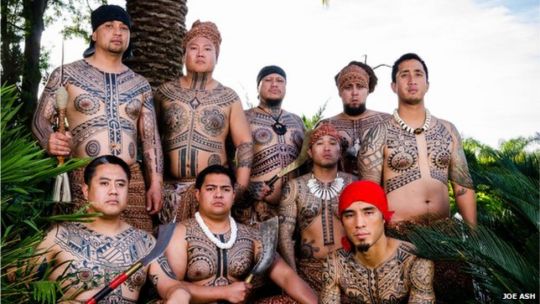
A photo of tattooed Filipino men posted on BBC and accredited to Joe Ash
Tattoos are often seen as integral cultural symbols in my different societies whether it be seen as something honorable or dishonorable. Even in the most straight-laced cultures, a tattoo acts as a mark of some form of the person's history and their standing in their communities as well as how people perceive them.
In a lot of modern cultures, the tattoo often have negative connotations, often associated with delinquency or criminal activity. Historically, however, they may have grander and more honorable significance in different societies. The communities that had existed in the Philippines prior to contact with Spain fits this similar pattern.
Before I start
As usual, the Philippines is a diverse country that has different traditions and histories that come from different ethnic groups and states, only being first unified under a government by colonization. Because of this, this post will only be able to cover parts of this culture and may not be able to fully encompass all Filipino traditions, practices, and beliefs about tattoos.
This is also given the fact that more specific information may be harder to come across or may not exist at all in a space I could easily access.
That being said, the general term for Filipino traditional (both precolonial and current) tattoo practices is batok, batik, patik, or patek depending on language or culture. It is also known as buri or burik in several other groups and languages. This word, however, isn't often used for typical tattooing in most modern communities.
The History
From a general understanding of a lot of precolonial Southeast Asian cultures, it can be assumed that precolonial Filipino societies heavily valued tattoos as their neighboring maritime SEAsian countries also had prior to the introduction of Abrahamic religions to the region which often discouraged or even forbade tattooing the skin.
Although this can be assumed, there were no known precolonial description nor record of these tattoos during the actual time period before Spanish contact. There is evidence found in some burial sites however, as discussed by social anthropologist Salvador-Amores in her paper The Recontextualization of Burik (Traditional Tattoos) of Kabayan Mummies in Benguet to Contemporary Practice (2012). In the paper, she focuses a section on the history of burik by explaining the Kabayan Mummies or the Fire Mummies of Benguet, Mountain Province.
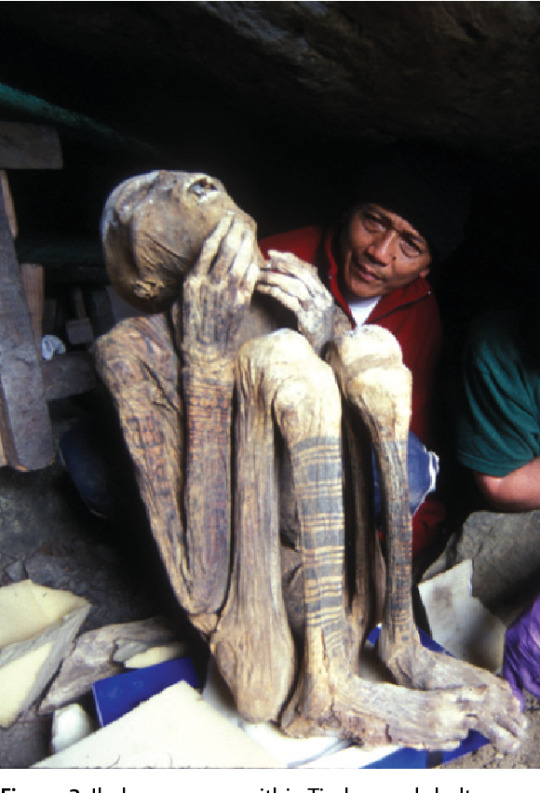
An image of one of the Kabayan Mummies uploaded by Dario Piombino-Miscali on ResearchGate.net
These remains had been dated back to the 13th century and are associated with the Ibaloi, an indigenous ethnic group from Mountain Province found in the northern parts of the island of Luzon. This does confirm that tattooing had been important to the people who had lived in this area during this time period as, in Salvador-Amores's paper, it can be noted that the tattooed mummies seem to be prominent with the adults.
I do have to note that the Ibaloi people, who are part of the larger Igorot ethnic group, were not fully colonized by the Spaniards and therefore does not share the similar Hispanic culture and history that a lot of Filipino groups have. They had only fully been integrated into the Philippines during the American colonial period where they and the other Igorots had been properly colonized by American and placed under the rule of the American-controlled Filipino government. (x)
Regardless, this does show that at least some cultures in the archipelago held tattoos with high importance and did not consider them as something negative compared to the modern perception of tattoos.
The first known illustration of tattooed Filipinos, however, was first seen in the Boxer Codex (circa 1590) during the early Spanish colonial period, written and illustrated by an unknown author.
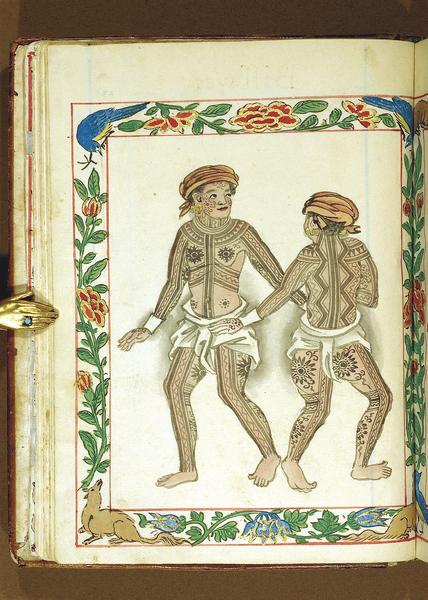
A page from the Boxer Codex (circa 1590), author uknown
This illustration seems to be that of the specific ethnolinguistic group, the Visayans as this page is next to another one labeled as "Biſſaya", a likely earlier spelling of Bisaya that uses the long s (ſ). This aligns with the description given as early as Antonio Pigaffatta, Ferdinand Magellan's chronicler, who consistently describes the Visayans that he has met as painted in his account of their arrival in the islands back in 1521.
The book The Philippine Islands 1493-1898 Vol. XII has compiled different first-hand and second-hand sources about the Philippines during the 15th through 19th century, with Vol. XII focusing on the early 17th century which aligns closely to the Boxer Codex. Within the text, there are several mentions of the "Pintados" or the Painted ones, even having an entire province be called the "province of Pintados".
It isn't made clear who the Pintados are besides the fact that they seem to be hostile towards the Spanish colonizers and had often fought battles with one of the letters even claiming that they had poisoned one of the Spaniards. It isn't until we reach the last part of the compilation which features Pedro Chirino's Relacion de las Yslas Filipinas which I had a hard time finding before but had now found a free and accessible copy. Within Chirino's writing, he explains that the Pintados seem to be a name given by the Spaniards to the Bisayans and further explains it as such:
"The people of the Bisayas are called the Pintados, because they are actually adorned with pictures --not because this is natural to them, although they are well built, of pleasing countenance, and white; but because they adorn their bodies with figures from head to foot, when they are young and have sufficient strength and energy to suffer the torment of the tattooing; and formerly they tattooed themselves when they had performed some act of valor."
Chirino even gives an explanation as to how precolonial Visayans tattooed their skin:
They tattoo themselves by pricking the skin until the blood comes, with sharp, delicate points, according to designs and lines which are first drawn by those who practice this art; and upon this freshly-bleeding surface they apply a black powder, which is never effaced. They do not tattoo the body all at the same time, but by degrees, so that the process often lasts a long time; in ancient times, for each part which was to be tattooed the person must perform some new act of bravery or valiant deed
It is notable, however, that not only did the Spanish not mention any tattoos on other Filipino groups such as the Tagalogs, but a lot of the illustrations in the Boxer Codex do not sport any tattoos at all which makes it confusing as to when had tattoos faded out of cultural significance in these other communities, likely even before Spanish contact.
Lane Wilcken, a researcher who studies the history of tattoos from the Philippines and the Pacific Islands, writes in his book Filipino Tattoos: Ancient to Modern (2010) that it may be possible that the Tagalogs may had lost their tattooing traditions shortly before Spanish contact during the recent islamization of their communities circa 1500 which was and specifically in the polity of Maynila. This may also be the case for the Moros which is a muslim ethnolinguistic group found in the island of Mindanao.
Either way. tattoos became more scarce within Filipino records after the arrival of the Spanish and the introduction of Christianity to the islands, save for some indigenous groups that were not fully colonized by Span like previously mentioned Igorot people.
Because of the spread and dominance of Christian and Islamic customs throughout the country, Batok, as it originally was, was lost to time with the lack of existing artists and cultural relevance tattoos. Tattoos didn't come back to the Filipino mainstream until modern tattoos became more prevalent especially in the mid to late 20th century, similar to its rise in popularity in Western cultures, and even then, it wasn't really what I would consider any traditional and is often negative.
Present Day
Like a lot of other countries, however, tattoos had seen a swing of opinion and is more accepted now as an art form rather than a sign of criminal activity but some stereotypes are still popular.
For instance, during the COVID-19 lockdown, the Department of Education provided modules for students to answer at home which would be then collected by the school from door to door. In one of these modules, Lea Salonga, a Filipino singer, complained on November 17, 2020 on her Facebook page of a discriminatory question that was found in one of the modules, pictured below
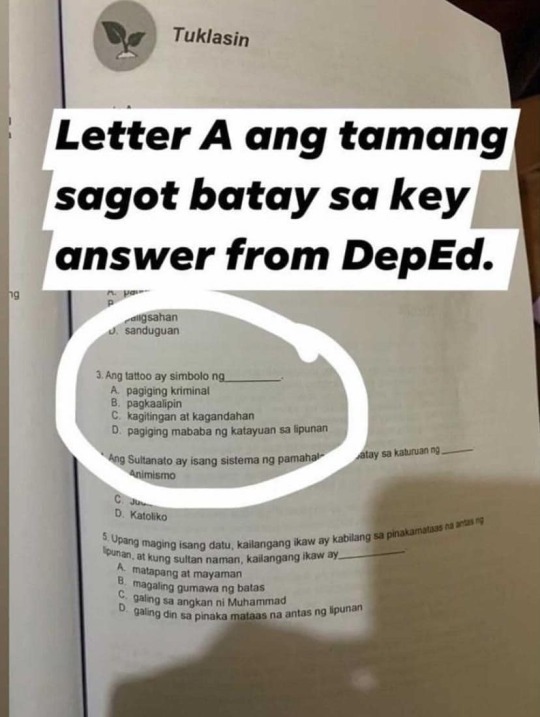
EN Translation:
White text: The answer is letter A based on the DepEd answer key. Module text: 3. Tattoos are a symbol of _____ A. being a criminal B. being a slave C. courage and beauty D. having a low standing in society
This controversy caused an uproar online and showed that there are a lot of Filipinos today that don't see a problem with tattoos and even see them as a positive. Two days after the image was posted on Salonga's page, the Department of Education publicly recognized the misstep and had issued that they officially recognized the controversial answer as an error.
It is important for me to note that, just like in a lot of countries, tattoos are typically not accepted in the corporate world and those who have them either have to get them removed or at least cover them up if they get hired at all. There's still a common idea that people with tattoos, if not dangerous, may be seen as unprofessional or even unclean which I do know is a similar thing that other countries may have as well.
As for batok, its comeback in the larger Filipino mainstream didn't return until some time in the late 2000s and 2010s when more international influence had resparked and interest in more ethnic cultures including the precolonial Filipino tattoos specifically because of the internet and the rise of social media. The current batok that we see outside of indigenous communities could be seen as a recreation of the extinct practices within the Philippines with some level of appropriation from related cultures (by appropriation, I mean this in a neutral way not a negative one).
It is argued whether or not the reconstructed practice could be considered traditional at all, but considering its heavy emphasis on the older designs found in historical illustrations as well as designs from indigenous communities that did not have practice eradicated by colonization, some also argue that the modern tattoos that has gained prominence because of modern technology and research is still valuable in a socio-anthropological sense.
As Salvado-Amore puts it
the successive phases and changes in the status of burik tattoos—enabled by the advent of modern technology, the Internet, and mass media—encourage an interaction between contemporary and historical influences rather than an extinction of past practice.
About Apo Whang-Od
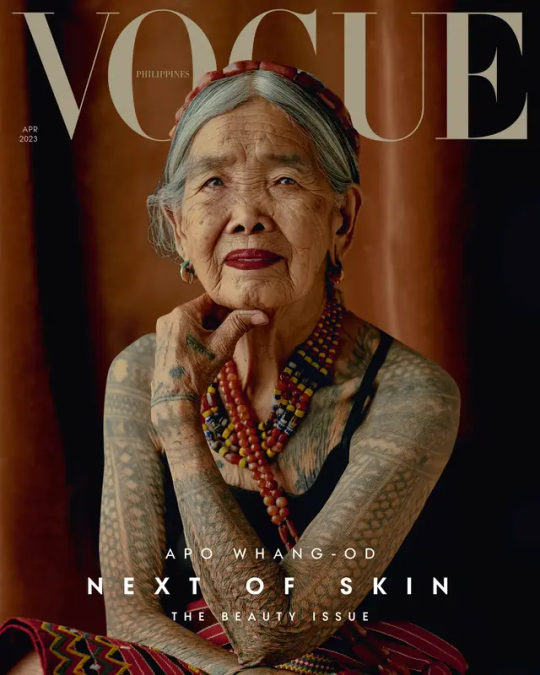
A magazine cover of Vogue featuring Whang-Od, a traditional tattoo artist from the Butbut people, a subgroup within the Kalinga ethnic group. (The rest of this section pulls from the same article by Vogue)
Any research about Filipino tattoos, especially in the modern day would be incomplete without any mention of Whang-Od, the most popular traditional tattoo artist from the Philippines.
Apo Whang-Od (b. February 17, 1917, a.k.a. Maria Oggay) is a member of the Butbut people of the Kalinga indigenous ethnic group from Kalinga province, Philippines. She is often known as one of the last mambabatok in the country which earned her fame and recognition internationally. She started her tattooing practice since she was a teenager at age 16, under the mentorship of her father and was the only known female mambabatok during her time.
For years, she was called on by different communities within her locale in order to tattoo important and symbolic tattoos on members of her and different communities after they had received certain milestones. Men were tattooed for different reasons than women as men were given their marks when they succeed in activities like headhunting, which was ritualistically important for the Butbut people while women were tattooed for reasons like fertility or beauty.
Because of American colonization, however, headhunting was prohibited so she was mostly tattooing women from then onward.
She started gaining recognition some time in the mid-2000s to the 2010s after she started serving foreign tourists, although she doesn't give them the more traditional symbols. Non-members of the group are given a set of tattoos that she could tattoo on anyone without any strong connection to the original meaning of the art.
Since tattooing was passed through family and Whang-Od herself didn't had any children, she was known as the last mambabatok for a time which caused concern for the extinction of the practice as she was already in her 90s when she gained notoriety, but she has since started training her grandniece Grace Palicas and later on her other grandniece Elyang Wigan and the two, who are now in their 20s, has since helped their great aunt dealing with their clientele.
Due to her fame, she is often the subject of foreign media and interest, even being invited by Vogue magazine to pose for one of their covers (pictured above) and is now known as the oldest Vogue cover model earlier this year at the age of 106.
Despite her fame and arguably cultural importance to not only the Kalinga people but the Philippines as well as online petitions since the 2010s to give her the recognition, she is not eligible to receive the National Artist award— one of the highest awards given to artists of most artistic fields of which only 81 people had received. Victorino Manalo, Chairman of the National Commission for Culture and Arts (NCCA) explains that this is because her craft, tattooing, isn't covered by the NCCA but by the Gawad sa Manlilikha ng Bayan (GAMBA, en. Award for Crafters/Creatives of the Nation) but there has been some discussion within the commission about this issue which still ended with her being denied. In light of this, she is now currently on the running to possibly receive the GAMBA award.
She has an online presence managed by others and she can be found via Facebook and Instagram.
Tattoos now, from my experience
As I had said before, tattoos these days are not as negatively seen as they were in the 20th century and had received a more positive reputation thanks to the rise of its social experience due to the internet and social media's prevalence in the country. As an art student, in fact, it's wasn't that surprising when I learned that one of my classmates had a tattoo and it was even a full sleeve! Now, as least three had tattoos before they graduated with one of them actually being a close friend of mine who's planning to get more despite their parents' disapproval.
Despite this, I still do have people in my life right now that see tattoos as undesirable and unclean, with stereotypes still being prevalent. I had once heard people speak of them in such a negative way but then make an exception for the artsy type of people? It's odd.
As for batok or batik, I had not seen a lot of people with these tattoos in my own life and had only seen it through articles and images circulated around by other people who I don't even know. I guess it makes sense as most people who do get tattoos similar to batok or batik often do it in tourist-y places or are foreigners who want to get a piece of Filipino culture on their way out of the country.
Besides more culture-focused people, batik or batok isn't as prevalent as some of these articles might make it seem and most typical Filipinos who don't come from these cultures are more likely to either not have tattoos at all or have similar tattoos to those that you may see in other countries.
Either way, tattoos could be so personal to a person and whether it's something as deeply-rooted to culture like batik or if it's just the names of your favorite K-Pop idol, that tattoo is important and has special meaning. Get whatever tattoo that you want or don't if you don't want any at all!
#mayaposts#mayapino#philippines#filipino#philippine history#philippine culture#filipino culture#filipino tattoos#philippine tattoos#history#culture#tattoos#apo whang-od#whang-od#mummy#mummies#death#long post#very long post
94 notes
·
View notes
Text
Self promotion!! My place has amazing dramas, and here to tell you guys about the new World War Two historical series:
Pulang Araw (2024)
Starring: Barbie Forteza, Alden Richards, David Licauco, and Sanya Lopez
Genre: War
Language: Filipino (original dub) , English Subtitles
Watch on: YouTube GMA official page (New episode every weekday, 8:00 pm Philippines Time)

Follows the story of 4 childhood friends in the midst of the American occupation and Japanese invasion.
The drama gives me horrible flashbacks of the war, which is good in a way since it's accurate to history. Personally I love Adelina the most (Barbie Forteza fan, she also starred in Maria Clara and Ibarra)
Credits to her for the picture
#Piri's picks#Filipino series#pulang araw#hws philippines#hetalia#Piri's roleplays#ask-the-pearloftheorient#hetalia axis powers#aph philippines#hetalia world series#hetalia world stars#hetalia world twinkle#OOC: Watch it guys it's so good I promise
12 notes
·
View notes